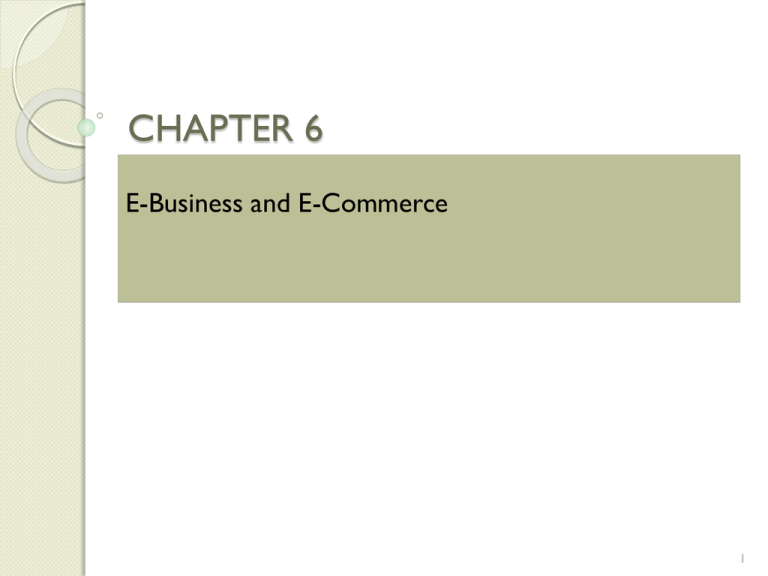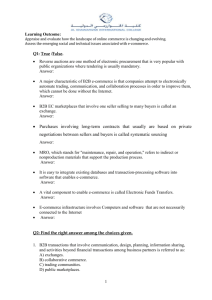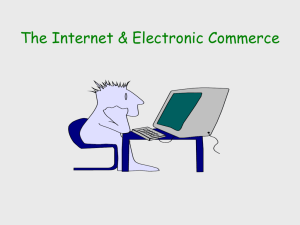
CHAPTER 6
E-Business and E-Commerce
1
Opening Case
Can Facebook generate revenue with advertising?
Facebook’s ultimate goal is to build a global website where you can just type
in anyone’s name, find that person, and communicate with him or her.
Currently, Facebook has more than 500 million active users and growing at
the amazing rate; In 2009 it registered growths of almost 5 million new users
per week. The average Facebook user spends 169 minutes per month on the
website.
The Business Problem
However, brand advertising on Facebook has been less than successful. This
lack of advertising success is a real concern for Facebook executives. In fact,
despite the site’s exploding popularity, as of mid-2009, Facebook was not yet
profitable. Accordingly, Facebook wants to develop a revenue stream from
advertising on its website.
2
Opening Case
Discussion
What type of e-commerce business model would Facebook, and
social network websites in general, fit into?
What challenges do social network websites face as a profitable
business model?
Could electronic payment methods add value to social network
websites?
What are the potential ethical concerns of using social networks to
conduct e-commerce?
3
Opening Case
What we learned from this case?
Electronic commerce offers two very important advantages to companies.
First, it increases an organization’s reach, defined as the number of
potential customers to whom the company can market its products.
Facebook is an excellent example of increased reach, as we saw in the
opening case.
Second, electronic commerce removes many of the barriers that previously
impeded entrepreneurs who start businesses. Facebook provides a
cautionary story here. Even though the company effectively used electronic
commerce to grow rapidly, its future is unclear because its revenue model
has, so far, not been as effective.
The important point here is that a company using electronic commerce,
despite all its advantages, still must have a viable method for generating
revenue, or the company will fail.
4
Agenda
6.1 Overview of E-Business & E-Commerce
6.1.1 Definitions and concepts
6.1.2 Types of E-Commerce
6.1.3 E-Commerce business models
6.1.4 Major E-Commerce mechanisms
6.1.5 Benefits and limitations of E-Commerce
6.2 Business-to-Consumer (B2C) E-Commerce
6.2.1 Definition and characteristics
6.2.2 Electronic storefronts and malls
6.2.3 On-Line service industries
6.2.4 Issues in E-Tailing
6.2.5 Online advertising
5
Agenda
6.3 Business-to-Business (B2B) E-Commerce
6.3.1 Definition
6.3.2 Types of B2B electronic commerce
6.4 Electronic Payments
6.5 Ethical and Legal Issues in E-Business
6
CHAPTER OVERVIEW
7
LEARNING OBJECTIVES
1.
Describe the different types of electronic commerce, its
mechanisms, and its limitations. (6.1)
2.
Describe B2C electronic commerce, e-tailing, and on-line
advertising. (6.2)
3.
Describe the main types of B2B electronic commerce. (6.3)
4.
Explain the main types of on-line electronic payment
methods.(6.4)
5.
Explain the main ethical and legal issues relating to ecommerce.(6.5)
8
6.1 Overview of E-Business & E-Commerce
6.1.1 Definitions and concepts
6.1.2 Types of E-Commerce
6.1.3 E-Commerce business models
6.1.4 Major E-Commerce mechanisms
6.1.5 Benefits and limitations of E-Commerce
9
6.1.1 Definitions and concepts
Definitions
Electronic commerce (e-commerce, EC) describes the process of
buying, selling, transferring, or exchanging of products, services or
information via computer networks, including the Internet.
E-business is a broader definition of EC, including buying and
selling of goods and services, and also servicing customers,
collaborating with partners, conducting e-learning and conducting
electronic transactions within an organization.
10
Concepts
Pure versus Partial Electronic Commerce
The degree of digitization refers to the extent to which the
commerce has been transformed from physical to digital. It can
relate to:
1)
the product or service being sold,
2)
the process by which the product or service is produced, or
3)
the delivery agent or intermediary. In other words, the product can be
physical or digital, the process can be physical or digital, and the
delivery agent can be physical or digital.
11
Depends on the degree of digitization involved.
◦ Brick-and-mortar organizations
◦ Click-and-mortar organizations
(e.g. BestBuy.ca, Futureshop.com)
◦ Virtual organizations, Pure play
(e.g. eBay.com, NetFlix.com)
12
Pure vs. Partial EC
--The product can be physical or digital.
--The process can be physical or digital.
--The delivery agent can be physical or digital.
Brick-and-mortar organizations are purely physical
organizations.
Virtual organizations are companies that are engaged only in
EC. (Also called pure play)
Click-and-mortar organizations are those that conduct some ecommerce activities, yet their business is primarily done in the
physical world. i.e. partial EC.
13
6.1.2 Types of E-Commerce
Business-to-Consumer (B2C)
Business-to-Business (B2B)
Consumer-to-Consumer (C2C)
Business-to-Employee (B2E)
E-Government
Mobile Commerce (m-commerce)
14
Business-to-consumer (B2C): the sellers are organizations and
the buyers are individuals.
Business-to-business (B2B): both the sellers and buyers are
business organizations. B2B represents the vast majority of ecommerce.
Consumer-to-consumer (C2C): an individual sells products or
services to other individuals.
Business-to-employee (B2E): An organization uses e-commerce
internally to provide information and services to its employees.
Companies allow employees to manage their benefits, take training
classes electronically; buy discounted insurance, travel packages, and
event tickets.
15
E-Government: the use of Internet Technology in general and ecommerce in particular to deliver information about public services
to citizens (called Government-to-citizen [G2C EC]), business
partners and suppliers (called government-to-business [G2B EC])
Mobile Commerce (m-commerce) refers to e-commerce that
is conducted in a wireless environment. For example, using a cell
phone to shop over the Internet.
16
6.1.3 E-Commerce business models
Online direct marketing
Name-your-own-price
Find-the-best-price
Viral marketing
Group purchasing
Online auctions
17
Affiliate marketing
Product customization
Deep discounters
Membership
Electronic tendering system
18
Online direct marketing: manufacturers or retailers sell directly
to customers.
Name-your-own-price: customers decide how much they want
to pay.
Find-the-best-price: customers specify a need and an
intermediary compares providers and shows the lowest price.
Viral marketing: receivers send information about your product
to their friends.
Bartering on-line: Intermediary administers on-line exchange of
surplus products and/or company receives “points” for its
contribution, and the points can be used to purchase other needed
items (www.bbu.com)
19
Online auctions: companies run auctions of various types on the
Internet.
Affiliate marketing:Vendors ask partners to place logos or
banners on partner’s site. If customers click on logo, go to vendor’s
site, and buy, then vendor pays commission to partners.
Product customization: customers use the Internet to selfconfigure products or services. Sellers then price them and fulfill
them quickly.
Deep discounters: company offers deep price discounts.
20
Group purchasing: small buyers aggregate demand to get a large
volume; then the group conducts tendering or negotiates a lower
price.
Membership: only members can use the services provided.
Electronic tendering system: businesses (or governments)
request quotes from suppliers; uses B2B (or G2B) with reverse
auctions. Image above is the Hong Kong Government’s electronic
tending system homepage.
Electric marketplaces and exchanges: transactions are
conducted efficiently (more information to buyers and sellers,
lower transaction costs) in electronic marketplaces (private or
public)
21
6.1.4 Major E-Commerce mechanisms
Auction
◦ Forward auctions
◦ Reverse auctions
Electronic marketplace ( e-marketplace is discussed in
section 6.3)
22
An auction is a competitive process in which either a seller solicits
consecutive bids from buyers or a buyer solicits consecutive bids from
sellers.
Sellers use a forward auction as a channel to many potential buyers.
Note that Sotheby’s uses forward auctions.
In reverse auctions, one buyer, usually an organization, wants to buy
a product or a service. The buyer posts a request for quotation (RFQ)
on its Web site or on a third-party Web site. The RFQ contains
detailed information on the desired purchase. Suppliers study the RFQ
and submit bids, and the lowest bid wins the auction.
In general, forward auctions result in higher prices over time, where
reverse auctions result in lower prices over time.
23
Bid
price
Bid
price
Time
Forward Auction
Time
Reverse Auction
24
6.1.5 Benefits and limitations of ECommerce
Benefits
Benefits to organizations
◦ Makes national and international markets more accessible
◦ Lowering costs of processing, distributing, and retrieving
information
Benefits to customers
◦ Access a vast number of products and services around the clock
(24/7/365)
Benefits to society
◦ Ability to easily and conveniently deliver information, services
and products to people in cities, rural areas and developing
countries
25
Limitations
Technological limitations
◦ Lack of universally accepted security standards
◦ Insufficient telecommunications bandwidth
◦ Expensive accessibility
Non-technological limitations
◦ Perception that EC is unsecure
◦ Unresolved legal issues
◦ Lacks a critical mass of sellers and buyers
26
6.2 Business-to-Consumer (B2C) ECommerce
6.2.1 Definition and characteristics
6.2.2 Electronic storefronts and malls
6.2.3 On-Line service industries
6.2.4 Issues in E-Tailing
6.2.5 Online advertising
27
6.2.1 Definition and characteristics
Business-to-consumer (B2C): the sellers are organizations and
the buyers are individuals. B2C electronic commerce is also known
as e-tailing.
◦ B2B is much larger than B2C by volume.
◦ B2C is more complex.
◦ B2C involves a large number of buyers making millions of diverse
transaction per day with a relatively small number of sellers.
28
6.2.2 Electronic storefronts and malls
Electronic retailing (e-tailing) is the direct sale of
products and services through electronic storefronts or
electronic malls, usually designed around an electronic
catalogue format and/or auctions.
An electronic storefront is a Web site that
represents a single store.
Electronic malls are collections of individual shops
under a single Internet address.
29
6.2.3 On-Line service industries
In addition to purchasing products, customers can also access
needed services via the Web.
A key issue is disintermediation in online service industries.
Intermediaries or middlemen provide information and/or provide
value-added services. When the function(s) of these intermediaries
can be automated or eliminated, this process is called
disintermediation.
30
Cyberbanking involves conducting banking activities from home, a
place of business, or on the road instead of at a physical bank
location.
Virtual banks are dedicated only to Internet transactions.
On-Line Securities Trading use computers to trade stocks,
bonds, and other financial instruments.
The On-Line Job Market: the Internet offers a promising new
environment for job seekers and for companies searching for hardto-find employees.
Travel Services: the Internet is an ideal place to plan, explore, and
arrange almost any trip economically.
31
6.2.4 Issues in E-Tailing
Channel conflict
Order fulfillment
???
32
Channel conflict occurs when manufacturers disintermediate
their channel partners,such as distributors, retailers, dealers, and
sales representatives, by selling their products directly to
consumers, usually over the Internet through electronic commerce.
Multichanneling is a process in which a company integrates its
offline and online channels.
Order fulfillment involves finding the product to be shipped;
packaging the product; arrange for speedy delivery to the
customer; and handle the return of unwanted or defective
products.
33
6.2.5 Online advertising
Advertising is an attempt to disseminate information
in order to influence a buyer-seller transaction. The
most common on-line advertising methods are:
◦
◦
◦
◦
◦
Banners
Pop-up ad
Pop-under ad
Permission marketing (e.g. AirCanada, WestJet)
Viral marketing
34
Banners are simply electronic billboards.
Pop-up ad appears in front of the current browser window.
Pop-under ad appears underneath the active window.
Permission marketing asks consumers to give their permission
to voluntarily accept online advertising and e-mail.
Viral marketing refers to online “word-of-mouth” marketing.
35
6.3 Business-to-Business (B2B) ECommerce
6.3.1 Definition
6.3.2 Types of B2B electronic commerce
36
6.3.1 Definition
In B2B e-commerce, the buyers and sellers are
organizations. B2B makes up about 85 percent of EC
volume.
It covers a broad spectrum of applications that enable
an enterprise to form electronic relationships with its
distributors, resellers, suppliers, customers, and other
partners.
37
6.3.2 Types of B2B electronic commerce
Sell-side marketplaces
Buy-side marketplaces
Electronic exchanges
38
In the sell-side marketplace, organizations sell their products or
services to other organizations Electronically from their own Web
site and/or from a third-party Web site. This model is similar to the
B2C model in which the buyer comes to the seller’s site, views
catalogs, and places an order. In the B2B sell-side marketplace, the
buyers are organizations.
The buy-side marketplace is a model in which organizations buy
needed products and services from other organizations
electronically.
Public exchanges have many buyers and many sellers. Private
exchanges have one buyer and many sellers. There are three basic
types of public exchanges: vertical, horizontal, and functional.
39
B2B Sell-Side Marketplace
Key mechanisms:
electronic catalogs and
forward auctions
40
B2B Buy-Side Marketplace
Key mechanism:
reverse auctions
41
Electronic Exchanges
42
6.4 Electronic Payments
Electronic payment systems enable you to pay for goods
and services electronically.
◦
◦
◦
◦
Electronic checks (e-checks)
Electronic credit cards
Purchasing cards
Electronic cash
Stored-value money cards
Smart cards
Person-to-person payments
43
44
Electronic checks (e-checks) are similar to paper checks and
are used mostly in B2B.
Electronic credit cards (Debt Cards, e-Credit, or e-Debt) allow
customers to charge online payments to their credit card account.
Purchasing cards are the B2B equivalent of electronic credit
cards and are typically used for unplanned B2B purchases.
45
Electronic cash
◦ Stored-value money cards allow you to store a fixed amount
of prepaid money and then spend it as necessary.
◦ Smart cards contain a chip called a microprocessor that can
store a considerable amount of information and are
multipurpose – can be used as a debit card, credit card or a
stored-value money card.
◦ Person-to-person payments are a form of e-cash that
enables two individuals or an individual and a business to
transfer funds without using a credit card.
◦ Digital Wallets are software mechanisms that provide security
measures, combined with convenience, to EC purchasing. The
wallet stores secured personal, shipping and credit card
information for use on line.
46
6.5 Ethical and Legal Issues in E-Business
Ethical Issues
◦ Privacy
◦ Disintermediation
47
Privacy: e-commerce provides opportunities for businesses and
employers to track individual activities on the WWW using cookies
or special spyware. This allows private/personal information to be
tracked, compiled, and stored as an individual profile. This profile
can be used or sold to other businesses for target marketing or by
employees to aide in personnel management decisions (i.e.,
promotions, raises, layoffs).
Disintermediation: middlemen or intermediaries (1) provide
information, and (2) perform value-added services such as
consulting. The first function can be fully automated, and the second
can be partially automated through e-marketplaces and portals for
free thereby causing job loss among intermediaries.
48
Legal Issues Specific to E-Commerce
◦ Fraud on the Internet
◦ Domain Names
Cybersquatting
◦ Taxes and Other Fees
◦ Copyright
49
Fraud on the Internet has grown faster than the
internet itself. Stock promoters falsely spread positive
rumours about the prospects of stocks that boost the
stock price for a quick profit.
Domain Names are assigned by a central non-profit
organization that checks for conflicts and possible
infringement of trademarks
Cybersquatting refers to the practice of registering
or using domain names for the purpose of profiting
from the goodwill or trademark belonging to someone
else.
Copyright is a grant that provides the creator of
intellectual property with the ownership of it for the life
of the creator plus 50 years in Canada.
50
Closing Case
Sales growth at the heart of Sears Canada’s new
e-commerce website
The Business Problem
Sears Canada, one of the largest retail store chains in
the country, has been trying to get customers back into
shopping. Without closing any of its stores, sales
decreased by 6.3 percent in a recent year, totalling $5.7
billion in annual revenue. On-line sales have also slowed
down to single-digit growth and now represent 10
percent of total sales.
51
Closing Case
Discussion
Why was Sears Canada so focused on improving the customer
experience in its new e-commerce website?
What role do new social media tools play in on-line stores such as
Sears.ca? What are the benefits? What are the disadvantages?
How could Sears Canada make its website more appealing to the
market segment for younger shoppers?
Identify any other on-line business models that Sears Canada could
benefit from.
52
Closing Case
The Results
The new e-commerce website has provided Sears with the
flexibility to respond to customers’ questions in an interactive way.
When a customer asked how a treadmill for sale could be folded,
an e-commerce team member videotaped himself doing it and
posted the video on YouTube and on the Sears.ca website.
Sears also saves on inventory costs since suppliers carry the
merchandise and ship it directly to customers. But one of the
greatest benefits of the new website is the almost endless range of
products that it carries: about 350,000 items are available on the
Sears.ca website, more than twice the number in one of its typical
department stores, and the number is planned to increase.
53
Copyright
Copyright © 2011 John Wiley & Sons Canada, Ltd. All rights reserved.
Reproduction or translation of this work beyond that permitted by
Access Copyright (the Canadian copyright licensing agency) is unlawful.
Requests for further information should be addressed to the
Permissions Department, John Wiley & Sons Canada, Ltd. The purchaser
may make back-up copies for his or her own use only and not for
distribution or resale. The author and the publisher assume no
responsibility for errors, omissions, or damages caused by the use of
these files or programs or from the use of the information contained
herein.
54




